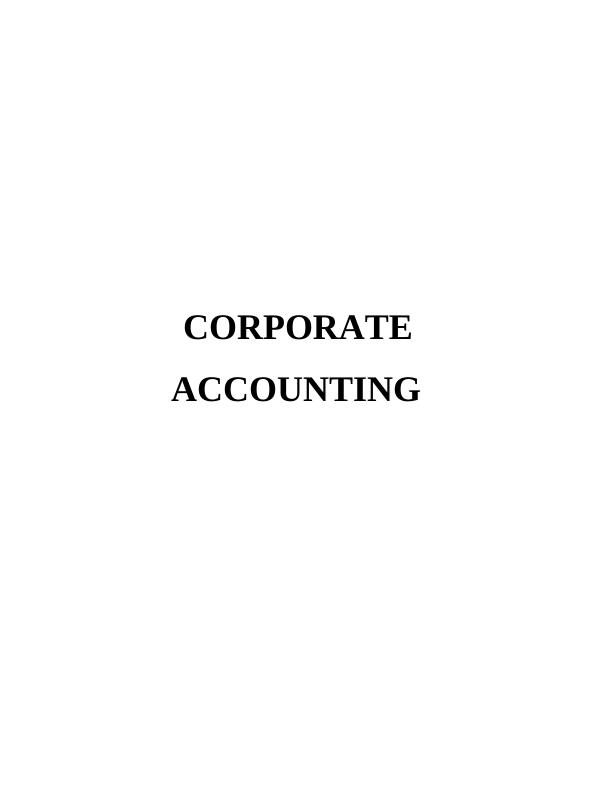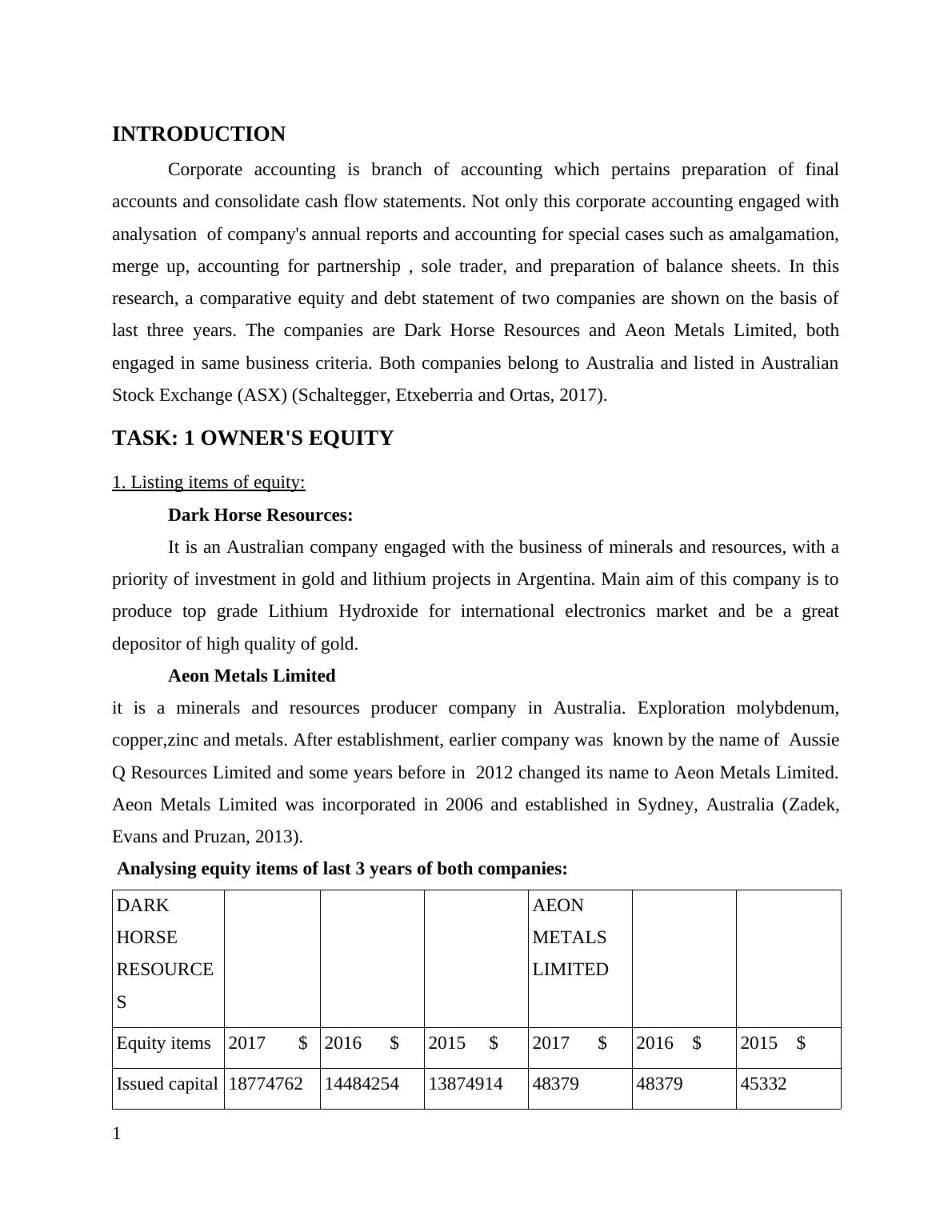Comparative analysis of equity and debt position
Added on 2021-01-02
14 Pages4273 Words105 Views
CORPORATE
ACCOUNTING
ACCOUNTING

Table of Contents
INTRODUCTION...........................................................................................................................1
TASK: 1 OWNER'S EQUITY........................................................................................................1
1. Listing items of equity:............................................................................................................1
TASK 2: CASH FLOW STATEMENTS........................................................................................3
2. Comparative analysis of equity and debt position:..................................................................3
3. List of items reported in cash flow statements of both companies: ........................................4
4. Comparative analysis of companies performance of last three years......................................6
TASK 3............................................................................................................................................7
6. List of items reported in comprehensive income statements: .................................................7
7. List of items reported in other comprehensive income statements:.........................................8
8. Comparative analyses of items listed in comprehensive income statements:..........................8
9. Should Comprehensive incomes included while evaluation of manager's performance: .......9
TASK 4: ACCOUNTING FOR CORPORATE INCOME TAX....................................................9
10. List of Tax expenses shown in financial statements of both companies: .............................9
11. Calculation of effective tax rate of both companies :............................................................9
12. List of deferred tax assets or liabilities reported in balance sheet:.....................................10
13. Changes in deferred tax assets or deferred liability:............................................................10
14. Calculation of Cash Tax amount:........................................................................................10
15. Calculation of Cash Tax Rate:.............................................................................................10
16. Difference between Cash Tax and Book Tax :....................................................................11
CONCLUSION............................................................................................................................11
REFERENCES..............................................................................................................................12
INTRODUCTION...........................................................................................................................1
TASK: 1 OWNER'S EQUITY........................................................................................................1
1. Listing items of equity:............................................................................................................1
TASK 2: CASH FLOW STATEMENTS........................................................................................3
2. Comparative analysis of equity and debt position:..................................................................3
3. List of items reported in cash flow statements of both companies: ........................................4
4. Comparative analysis of companies performance of last three years......................................6
TASK 3............................................................................................................................................7
6. List of items reported in comprehensive income statements: .................................................7
7. List of items reported in other comprehensive income statements:.........................................8
8. Comparative analyses of items listed in comprehensive income statements:..........................8
9. Should Comprehensive incomes included while evaluation of manager's performance: .......9
TASK 4: ACCOUNTING FOR CORPORATE INCOME TAX....................................................9
10. List of Tax expenses shown in financial statements of both companies: .............................9
11. Calculation of effective tax rate of both companies :............................................................9
12. List of deferred tax assets or liabilities reported in balance sheet:.....................................10
13. Changes in deferred tax assets or deferred liability:............................................................10
14. Calculation of Cash Tax amount:........................................................................................10
15. Calculation of Cash Tax Rate:.............................................................................................10
16. Difference between Cash Tax and Book Tax :....................................................................11
CONCLUSION............................................................................................................................11
REFERENCES..............................................................................................................................12

INTRODUCTION
Corporate accounting is branch of accounting which pertains preparation of final
accounts and consolidate cash flow statements. Not only this corporate accounting engaged with
analysation of company's annual reports and accounting for special cases such as amalgamation,
merge up, accounting for partnership , sole trader, and preparation of balance sheets. In this
research, a comparative equity and debt statement of two companies are shown on the basis of
last three years. The companies are Dark Horse Resources and Aeon Metals Limited, both
engaged in same business criteria. Both companies belong to Australia and listed in Australian
Stock Exchange (ASX) (Schaltegger, Etxeberria and Ortas, 2017).
TASK: 1 OWNER'S EQUITY
1. Listing items of equity:
Dark Horse Resources:
It is an Australian company engaged with the business of minerals and resources, with a
priority of investment in gold and lithium projects in Argentina. Main aim of this company is to
produce top grade Lithium Hydroxide for international electronics market and be a great
depositor of high quality of gold.
Aeon Metals Limited
it is a minerals and resources producer company in Australia. Exploration molybdenum,
copper,zinc and metals. After establishment, earlier company was known by the name of Aussie
Q Resources Limited and some years before in 2012 changed its name to Aeon Metals Limited.
Aeon Metals Limited was incorporated in 2006 and established in Sydney, Australia (Zadek,
Evans and Pruzan, 2013).
Analysing equity items of last 3 years of both companies:
DARK
HORSE
RESOURCE
S
AEON
METALS
LIMITED
Equity items 2017 $ 2016 $ 2015 $ 2017 $ 2016 $ 2015 $
Issued capital 18774762 14484254 13874914 48379 48379 45332
1
Corporate accounting is branch of accounting which pertains preparation of final
accounts and consolidate cash flow statements. Not only this corporate accounting engaged with
analysation of company's annual reports and accounting for special cases such as amalgamation,
merge up, accounting for partnership , sole trader, and preparation of balance sheets. In this
research, a comparative equity and debt statement of two companies are shown on the basis of
last three years. The companies are Dark Horse Resources and Aeon Metals Limited, both
engaged in same business criteria. Both companies belong to Australia and listed in Australian
Stock Exchange (ASX) (Schaltegger, Etxeberria and Ortas, 2017).
TASK: 1 OWNER'S EQUITY
1. Listing items of equity:
Dark Horse Resources:
It is an Australian company engaged with the business of minerals and resources, with a
priority of investment in gold and lithium projects in Argentina. Main aim of this company is to
produce top grade Lithium Hydroxide for international electronics market and be a great
depositor of high quality of gold.
Aeon Metals Limited
it is a minerals and resources producer company in Australia. Exploration molybdenum,
copper,zinc and metals. After establishment, earlier company was known by the name of Aussie
Q Resources Limited and some years before in 2012 changed its name to Aeon Metals Limited.
Aeon Metals Limited was incorporated in 2006 and established in Sydney, Australia (Zadek,
Evans and Pruzan, 2013).
Analysing equity items of last 3 years of both companies:
DARK
HORSE
RESOURCE
S
AEON
METALS
LIMITED
Equity items 2017 $ 2016 $ 2015 $ 2017 $ 2016 $ 2015 $
Issued capital 18774762 14484254 13874914 48379 48379 45332
1

Reserves 900888 843667 829762 40960 8830 5523
accumulated
losses
-10588573 -14675068 -13107220 -28163 -24682 -22217
Net equity 9087077 652853 1597456 24312 32527 28638
ISSUED CAPITAL:
The issued capital is part of company's authorised capital which issued to public or
private /existing shareholders. it is that part of capital on which the allotment of shares is made.
Moreover, issued capital of Dark Horse Resources increases year after year, but issued capital of
Aeon Metals Limited is stable since last year.
Reasons behind increment in issued capital of Dark Horse resources may be, company
wants to reduce its debts, or company plans to invest in new project, or may be due to excess of
retained earnings that's why company decided to issue new shares to existing shareholders and
utilise the retained earnings.
But, in case of Aeon metals limited the issued capital is stable since last year means
company wants to increase debts ratio in capital structure of company. In year 2015-16 the
issued capital of company increases but in year 2017 company didn't issue shares. Issued capital
increases by steady rate (DeBusk, 2012).
RESERVES:
Reserves are the assets of company in liquid form, maintained to meet the future payment
and unforeseen or contingent liability. Moreover, it shows the liquidity form of company,
generated from retained earnings and extra profits(profits of share holder not yet distributedas
dividends) of company.
In above comparative statement, reserves increases year after year, reserves depend on
funds availability and shows liquidity performance of company as shown above, both companies
have reserves normally built up from retained earnings and extra profits (Edgerton, 2012).
ACCUMULATED LOSSES:
Accumulated losses are the negative balances of company's retained earnings. Retained
earnings are the undistributed profits or dividends of shareholder held with the company. At the
end of accounting era, the net loss/income transfers from consolidate profit and loss statement to
retained earnings account. The favourable balance of retained earning account is called
2
accumulated
losses
-10588573 -14675068 -13107220 -28163 -24682 -22217
Net equity 9087077 652853 1597456 24312 32527 28638
ISSUED CAPITAL:
The issued capital is part of company's authorised capital which issued to public or
private /existing shareholders. it is that part of capital on which the allotment of shares is made.
Moreover, issued capital of Dark Horse Resources increases year after year, but issued capital of
Aeon Metals Limited is stable since last year.
Reasons behind increment in issued capital of Dark Horse resources may be, company
wants to reduce its debts, or company plans to invest in new project, or may be due to excess of
retained earnings that's why company decided to issue new shares to existing shareholders and
utilise the retained earnings.
But, in case of Aeon metals limited the issued capital is stable since last year means
company wants to increase debts ratio in capital structure of company. In year 2015-16 the
issued capital of company increases but in year 2017 company didn't issue shares. Issued capital
increases by steady rate (DeBusk, 2012).
RESERVES:
Reserves are the assets of company in liquid form, maintained to meet the future payment
and unforeseen or contingent liability. Moreover, it shows the liquidity form of company,
generated from retained earnings and extra profits(profits of share holder not yet distributedas
dividends) of company.
In above comparative statement, reserves increases year after year, reserves depend on
funds availability and shows liquidity performance of company as shown above, both companies
have reserves normally built up from retained earnings and extra profits (Edgerton, 2012).
ACCUMULATED LOSSES:
Accumulated losses are the negative balances of company's retained earnings. Retained
earnings are the undistributed profits or dividends of shareholder held with the company. At the
end of accounting era, the net loss/income transfers from consolidate profit and loss statement to
retained earnings account. The favourable balance of retained earning account is called
2

End of preview
Want to access all the pages? Upload your documents or become a member.
Related Documents
Corporate Accounting: Analysis of Finance Statements of ASX Listed Entitieslg...
|25
|4640
|111
Corporate Accounting: Financial Analysis of Rio Tinto, Altura Mining, and BHP Billitonlg...
|43
|5039
|237
Corporate Accounting: Financial Statement Analysis of ASX Listed Companieslg...
|32
|4473
|262
Corporate Accounting Analysis of BCI Limited and Boral Limitedlg...
|16
|4765
|370
(Solution) Corporate Accounting : PDFlg...
|26
|4200
|426
Assignment on Corporate Accounting (Docs)lg...
|18
|4388
|122
